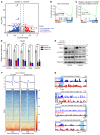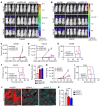Lactate reprograms glioblastoma immunity through CBX3-regulated histone lactylation
- PMID: 39545414
- PMCID: PMC11563687
- DOI: 10.1172/JCI176851
Lactate reprograms glioblastoma immunity through CBX3-regulated histone lactylation
Abstract
Glioblastoma (GBM), an aggressive brain malignancy with a cellular hierarchy dominated by GBM stem cells (GSCs), evades antitumor immunity through mechanisms that remain incompletely understood. Like most cancers, GBMs undergo metabolic reprogramming toward glycolysis to generate lactate. Here, we show that lactate production by patient-derived GSCs and microglia/macrophages induces tumor cell epigenetic reprogramming through histone lactylation, an activating modification that leads to immunosuppressive transcriptional programs and suppression of phagocytosis via transcriptional upregulation of CD47, a "don't eat me" signal, in GBM cells. Leveraging these findings, pharmacologic targeting of lactate production augments efficacy of anti-CD47 therapy. Mechanistically, lactylated histone interacts with the heterochromatin component chromobox protein homolog 3 (CBX3). Although CBX3 does not possess direct lactyltransferase activity, CBX3 binds histone acetyltransferase (HAT) EP300 to induce increased EP300 substrate specificity toward lactyl-CoA and a transcriptional shift toward an immunosuppressive cytokine profile. Targeting CBX3 inhibits tumor growth by both tumor cell-intrinsic mechanisms and increased tumor cell phagocytosis. Collectively, these results suggest that lactate mediates metabolism-induced epigenetic reprogramming in GBM that contributes to CD47-dependent immune evasion, which can be leveraged to augment efficacy of immuno-oncology therapies.
Keywords: Adult stem cells; Brain cancer; Epigenetics; Metabolism; Oncology.
Conflict of interest statement
Figures










References
MeSH terms
Substances
Grants and funding
LinkOut - more resources
Full Text Sources
Research Materials
Miscellaneous

